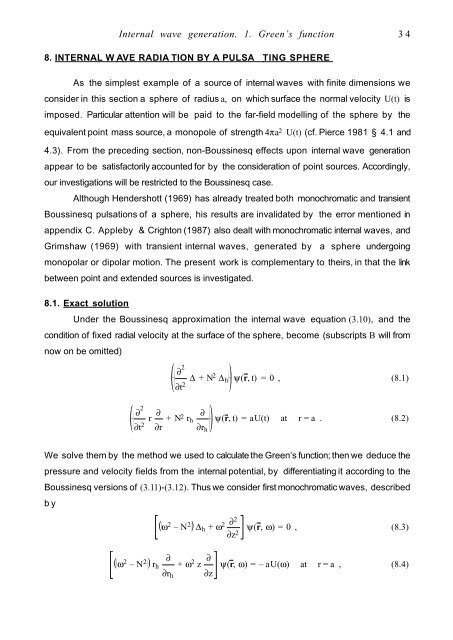Internal Wave Generation in Uniformly Stratified Fluids. 1 ... - LEGI
Internal Wave Generation in Uniformly Stratified Fluids. 1 ... - LEGI
Internal Wave Generation in Uniformly Stratified Fluids. 1 ... - LEGI
You also want an ePaper? Increase the reach of your titles
YUMPU automatically turns print PDFs into web optimized ePapers that Google loves.
8. INTERNAL W AVE RADIA TION BY A PULSA TING SPHERE<br />
As the simplest example of a source of <strong>in</strong>ternal waves with f<strong>in</strong>ite dimensions we<br />
consider <strong>in</strong> this section a sphere of radius a, on which surface the normal velocity U(t) is<br />
imposed. Particular attention will be paid to the far-field modell<strong>in</strong>g of the sphere by the<br />
equivalent po<strong>in</strong>t mass source, a monopole of strength 4πa 2 U(t) (cf. Pierce 1981 § 4.1 and<br />
4.3). From the preced<strong>in</strong>g section, non-Bouss<strong>in</strong>esq effects upon <strong>in</strong>ternal wave generation<br />
appear to be satisfactorily accounted for by the consideration of po<strong>in</strong>t sources. Accord<strong>in</strong>gly,<br />
our <strong>in</strong>vestigations will be restricted to the Bouss<strong>in</strong>esq case.<br />
Although Hendershott (1969) has already treated both monochromatic and transient<br />
Bouss<strong>in</strong>esq pulsations of a sphere, his results are <strong>in</strong>validated by the error mentioned <strong>in</strong><br />
appendix C. Appleby & Crighton (1987) also dealt with monochromatic <strong>in</strong>ternal waves, and<br />
Grimshaw (1969) with transient <strong>in</strong>ternal waves, generated by a sphere undergo<strong>in</strong>g<br />
monopolar or dipolar motion. The present work is complementary to theirs, <strong>in</strong> that the l<strong>in</strong>k<br />
between po<strong>in</strong>t and extended sources is <strong>in</strong>vestigated.<br />
8.1. Exact solution<br />
Under the Bouss<strong>in</strong>esq approximation the <strong>in</strong>ternal wave equation (3.10), and the<br />
condition of fixed radial velocity at the surface of the sphere, become (subscripts B will from<br />
now on be omitted)<br />
∂ 2<br />
∂<br />
r<br />
∂t2 ∂r<br />
∂ 2<br />
∂t 2 Δ + N2 Δh ψ(r, t) = 0 , (8.1)<br />
+ N 2 rh ∂<br />
∂rh<br />
ψ(r, t) = aU(t) at r = a . (8.2)<br />
We solve them by the method we used to calculate the Green’s function; then we deduce the<br />
pressure and velocity fields from the <strong>in</strong>ternal potential, by differentiat<strong>in</strong>g it accord<strong>in</strong>g to the<br />
Bouss<strong>in</strong>esq versions of (3.11)-(3.12). Thus we consider first monochromatic waves, described<br />
by<br />
<strong>Internal</strong> wave generation. 1. Green’s function 34<br />
ω 2 – N 2 rh ∂<br />
ω 2 – N 2 Δh + ω<br />
∂rh<br />
+ ω 2 z ∂<br />
∂z<br />
2 ∂2<br />
ψ(r, ω) = 0 , (8.3)<br />
∂z2 ψ(r, ω) = – aU(ω) at r = a , (8.4)


